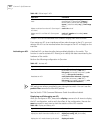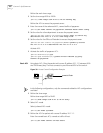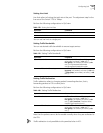
162 CHAPTER 7: QOS/ OPERATION
Perform the following two configuration tasks in system view.
Setting Port Mirroring
Port mirroring means duplicating data on the monitored port to the designated
monitor port, for purpose of data analysis and supervision. The switch supports
many-to-one mirroring, that is, you can duplicate packets from multiple ports to a
monitoring port.
You can also specify the monitoring direction for only inbound or outbound
packets.
Perform the following configurations in system view.
You can configure up to 20 mirroring groups, Each group includes one monitoring
port and multiple monitored ports.
The monitoring port and the monitored ports must be on the same interface unit.
For a non-48-port interface unit, only one mirroring group can be configured in
one direction. For example, you can only configure one mirroring group for the
inbound packets on one interface unit. Failure will be prompted if you configure a
second. The same restriction applies to outbound packets.
For a 48-port interface unit, the monitoring port and the monitored port must all
be at the ports 1~24 or the ports 25~48, at which only one mirroring group can
be configured in one direction.
Setting Queue Scheduling
Queue scheduling is often used in solving the problem of resource contention
during network congestion.
Each port supports eight outbound queues. The switch only supports SP
algorithm, but you can distribute packets into the target queues according to
several types of priority. The following tables show the mapping between
outbound queues and priority schemes.
Table 170 Setting Port Mirroring
Operation Command
Set port mirroring mirroring-group groupid { inbound |
outbound } mirroring-port-list &<1-8>
mirrored-to monitor-port
Remove port mirroring undo mirroring-group groupid
Table 171 Mapping Between 802.1p Priority Levels and Outbound Queues
802.1p priority level Queues
2 0
0 1
1 2
3 3
4 4
5 5
6 6


















